


 |
 |
 |

|
|
The Lockheed A-12 family, known as the Blackbirds, were designed by Clarence "Kelly" Johnson. They were constructed mostly of titanium to withstand aerodynamic heating. Fueled by JP-7, the Blackbirds were capable of cruising at Mach 3.2 and attaining altitudes above 80,000 feet. The first version, a CIA reconnaissance aircraft that first flew in April 1962 was called the A-12. An interceptor version developed in 1963 under the designation YF-12A. A USAF reconnaissance variant, called the SR-71, was first flown in 1964. The A-12 and SR-71 designs included leading and trailing edges made of high-temperature fiberglass-asbestos laminates.
The YF-12 "Blackbird" was an experimental fighter-interceptor version of the Lockheed A-12 design and more especially the
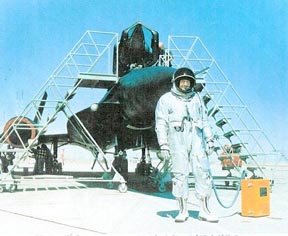 Lockheed Test pilot Jim Eastham, first to fly the YF-12. |
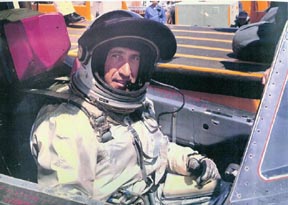 CIA A-12 Project Oxcart pilot Bill Skliar - first CIA pilot to fly the A-12. Switched from A-12 to YF-12 flight testing at Area 51 and stayed with the program as an Air Force officer when the YF-12 moved to Edwards AFB. |
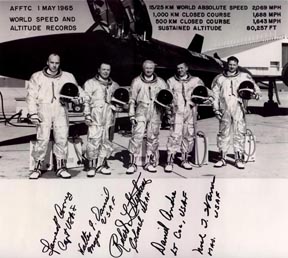 |
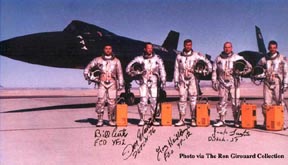 |
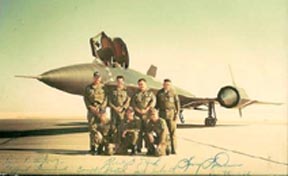 Enlisted crew for speed run |
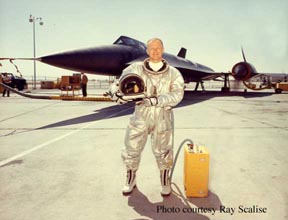 |
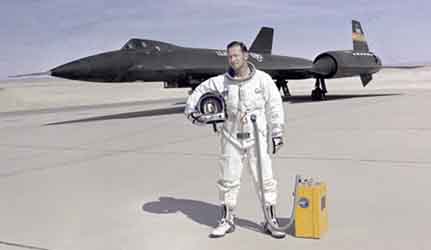 NASA test pilot Don Mallick, in full pressure suit, stands in front of the YF-12A (60-6935). Don is ready for a flight across the Western United States." |
similar A-12 aircraft, which had a lower radar cross-section. In Air Force flight tests on May 1, 1965, the YF-12 set a speed record of 2,070.101 mph and an altitude record of 80,258 feet. First
publicly displayed at Edwards Air Force base in 1964, the YF-12 was never adopted by the military as an operational aircraft. It was, however, a precursor to the SR-71 Blackbird reconnaissance plane.
NASA flew two YF-12 aircraft in a joint Air Force- NASA research program at the NASA Flight Research Center (now the NASA Dryden Flight Research Center) between 1969 and 1979, although the second plane, piloted primarily by the Air Force, was lost to an inflight fire in 1971.
The two YF-12 aircraft bore the serial numbers 60-6935 and 60-6936.
The YF-12 allowed NASA researchers at all four of the agency aeronautical centers (Langley, Lewis, and Ames as well as the Flight Research Center) to study the thermal, structural, and aerodynamic effects of sustained, high-altitude, Mach 3 flight.
Painted flat-black, the YF-12 was fabricated primarily from titanium alloy, which enabled it to withstand skin temperatures of over 500 degrees Fahrenheit.
Torrey Larsen, Senior Flight Test Engineer on YF-12 program reported that very early in the test program the dynamics of the main gear struts of the YF-12 their stiffness as a result of the titanium structure and the titanium struts resulted in a combination that would have been significantly different than any of the other aircraft of the conventional design and material used at this period. This was in early 1963 during the initial testing of the interceptor version of the blackbird (YF-12). This unique structural stiffness and the dynamic response of the anti-skid system to pilot brake application would have been significantly different than other aluminum structure to aircraft in the dynamics of the landing gear braking system, etc. would have been hard to anticipate.
At this phase of development in the YF-12, it was a new design and very classified activity therefore many of our vendors of systems utilized in the design were not consulted nor are given access to the details of the Blackbird design. It was my understanding that many of the systems like the anti-skid and other similar hardware were taken off the shelf and used without the provider of that equipment even aware of Lockheed Skunk Works involvement. Because of this aircraft is very classified nature that in 1963 there was no access to the provider of the equipment by either the Lockheed designer or the Lockheed test people involved. As an ordinary course, the test engineer would have contacted the vendor and discussed the problems encountered in the test program. In that this was not available no interface with the vendor could be done. In the test group, we concluded that the spring rate of the titanium structure and the dynamic nature of the anti-skid system were in conflict and should be filtered to prevent the strut walking that we were experiencing. The program utilized a Band-Aid fix designed by Harry Hahn, the systems engineer on the YF-12 program until the program was to a degree released from the strict security limits that we were under up to the time that President Johnson announced the Interceptor version of the Blackbird.
Work on the YF-12 had begun in secret in the late1950's at the Lockheed Advanced Development Projects office, better as known the "Skunk Works," in Burbank, California. Flight data remained classified long after President Lyndon Johnson announced the plane's existence on Feb. 29, 1964. After the announcement, the plane received the Air Force designation YF-12A..
The President’s Announcement
The President’s Announcement
In 1963 President Johnson was brought up to date on the project a week after taking office and directed the preparation of a paper for an announcement in the spring of 1964. Then at his press conference on 24 February, he read a statement of which the first paragraph was as follows:
“The United States has successfully developed an advanced experimental jet aircraft, the A-11, already tested in sustained flight at more than 2,000 miles per hour and altitudes in excess of 70,000 feet. The performance of the A-11 far exceeds that of any other aircraft in the world today. The development of this aircraft has been made possible by significant advances in aircraft technology of great significance for both military and commercial applications. Several A-11 aircraft are now being flight tested at Edwards Air Force Base in California. The existence of this program is being disclosed today to permit the orderly exploitation of this advanced technology in our military and commercial program
The president went on to mention the “mastery of the metallurgy and fabrication of titanium metal” which has been achieved, gave credit to Lockheed and to Pratt & Whitney, Remarked that appropriate members of the Senate and House had been kept fully informed, and prescribed that the detailed performance of the A-11 would be kept strictly classified. The President’s reference to the “A-11” was of course deliberate. “A- 11” had been the original design designation for the all-metal aircraft first proposed by Lockheed; subsequently it became the design designation for the Air Force YF-12A interceptor which differed from its parent mainly in that it carried a second man for launching air-to-air missiles. To preserve the distinction between the A-11 and the A- 12 Security had briefed practically all participating personnel in government and industry on the impending announcement. OXCART secrecy continued in effect. There was considerable speculation about an Agency role in the A-11 development, but the government never acknowledged it. News headlines ranged from “US has dozen A-11 jets already flying” to “Secret of the sizzling new plane probably history’s best kept.
The President also said that “the A-11 aircraft now at Edwards Air Force Base are undergoing extensive tests to determine their capabilities as long-range interceptors.” It was true that the Air Force in October 1960, had contracted for three interceptor versions of the A-12, and they were by this time available. However, at the moment when the President spoke, there was no A-11’s at Edwards, and there had never been. Project officials had known that the public announcement was about to be made but not told exactly when. Caught by surprise, they hastily flew two AirForce YF-12A’s to Edwards to support the President’s statement. So rushed was this operation, so speedily were the aircraft put into hangars upon arrival, that heat from them activated the hangar sprinkler system, dousing the reception team which awaited them.
Thenceforth, while the OXCART continued its secret career at its site, the A-11 performed at Edwards Air Force Base in a considerable glare of publicity. Pictures of the aircraft appeared in the press, correspondents could look at it and Marvel, stories could be written. Virtually no details were made available, but the technical journals nevertheless had a field day. The unclassified Air Force and Space Digest, for example, published a lengthy article in its issue of April 1964, commencing: “The official pictures and statements tell very little about the A-11. However, the technical literature from open sources, when carefully interpreted, tells a good deal about what it could and, more importantly, what it could not be.
The YF-12A was quite similar in overall configuration to the A-12 that derived it. It differed from the A-12 primarily in having a second crewman in a position immediately behind the pilot This second crewman was added to operate the extremely powerful and capable Hughes AN/ASG-18 pulse Doppler fire control radar, initially developed for the F-108 Rapier. The AN/ASG-18 installed in the extreme nose of the aircraft, with the forward chines being cut back to accommodate the 40-inch radome. The ASG-18 radar supposedly had a search range as high as 500 miles. Infrared sensors installed in the forward edges of the cut- back chines.
he YF-12A also differed from the A-12 in having an armament. This armament consisted of four Hughes AIM-47A Falcon air-to-air missiles housed internally in chine bays that had previously been used to carry the reconnaissance equipment. The AIM-47A initially known as the GAR-9 and (like the ASG-18 radar)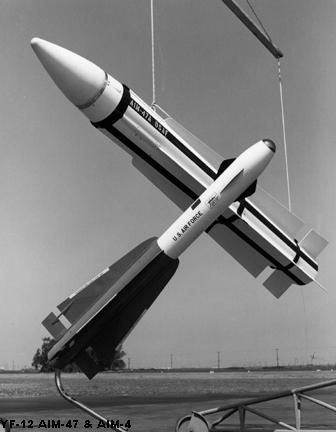 intended for the F-108 Rapier. When fired, the Falcon
missiles explosively ejected from their bays, and their rocket motors fired. Powered by a storable-propellant liquid-fuelled rocket, the AIM-47A had a maximum speed of Mach 6 and an interception range of 115 miles. It had a launch weight of about 800 pounds. The missile relied on semiactive radar homing for midcourse guidance to the immediate vicinity of the target, homing in on reflections off the target resulting from transmissions from the massive ASG-18 radar. However, it used terminal infrared homing for the final run for the target. The AIM-47 could carry a 250-kiloton nuclear warhead.
intended for the F-108 Rapier. When fired, the Falcon
missiles explosively ejected from their bays, and their rocket motors fired. Powered by a storable-propellant liquid-fuelled rocket, the AIM-47A had a maximum speed of Mach 6 and an interception range of 115 miles. It had a launch weight of about 800 pounds. The missile relied on semiactive radar homing for midcourse guidance to the immediate vicinity of the target, homing in on reflections off the target resulting from transmissions from the massive ASG-18 radar. However, it used terminal infrared homing for the final run for the target. The AIM-47 could carry a 250-kiloton nuclear warhead.
Although it yielded large amounts of research data, the YF-12 program terminated in the late 1970s when the NASA research agenda had shifted from speed to efficiency. During its nine-year life, the YF-12 research program logged 297 flights and approximately 450 flight hours (including hours in an SR-71A designated YF-12C, on which there is more information below).
The YF-12 carried a crew of two -- a pilot and a flight engineer. Research pilots Fitzhugh Fulton and Donald Mallick flew NASA YF-12 flights at the NASA Flight Research Center (re-designated the Dryden Flight Research Center in 1976) from 1970 to 1979, with several other pilots performing familiarization flights. The flight engineers on the YF-12 crews were Victor Horton and Ray Young. Air Force crews also conducted testing.
| TARGET | TARGET MACH/ALT | YF-12 MACH/ALT | LAUNCH RANGE | RESULTS |
| Q2C | .9/40K | 2.2/65K | 36NM | Direct Hit |
| Q2C | .8/20K | 2.3/65K | 36NM | No Guide (lost power) |
| Q2C | .8/20K | 3.2/75K | 34NM | 6 feet Guide |
| Q2C | .6/1.5K | 3.2/75K | 30NM | 9 feet Guide |
| QB-47 | 6. /1.5K | 3.2/75K | 31NM | Direct Hit |
| Q2C | .6/20K | 3.2/74K | 35NM | 99 feet Guide |
| QB-47 | .6/500 ft over land | 3.2/74K | 33NM | 45 feet Guide |
Under its research agreement with NASA, the Air Force provided the agency with two YF-12A aircraft in 1969. On June 24, 1971, one of the planes (serial no. 60-6936) experienced an inflight fuel line failure and engine fire. Unable to save the smoking aircraft, Air Force pilot Lt. Col. Ronald Layton and systems engineer Major Billy A. Curtis ejected and were not injured, but lost the YF-12A in a fiery explosion in the desert. About this time, Dryden acquired a so-called YF-12C, which was, in fact, a then-secret SR-71A (serial no. 61-7951) given the NASA tail no. 60-6937. The reason for this bit for subterfuge lay in the fact that NASA while flying the YF-12A interceptor version of the aircraft, was not allowed to possess the strategic reconnaissance version for some time. The bogus tail number belonged to a Lockheed A-12 (serial no. 60-6937), but the existence of the A-12 remained classified until 1982. The tail number 06937 was selected because it followed in the sequence of tail numbers assigned to the three existing YF-12A aircraft: 06934, 06935, and 06936. The SR-71 differed from the YF-12A in that the YF-12A had a round nose while the SR-71 had its chine carried forward to the nose of the airplane. There were other differences in internal and external configuration, but the two aircraft shared common inlet designs, structural concepts, and subsystems.
The YF-12 project provided a wealth of information on systems integration, Mach
3 handling and performance, aerodynamics, propulsion, controls, structures, and
subsystems.
The NASA YF-12 research program was ambitious; the aircraft
flew an average of once a week unless down for extended maintenance or
modification. Program expenses averaged $3.1 million per year just to run the
flight tests. NASA crews for the YF-12 included pilots Fitzhugh Fulton and
Donald Mallick, and flight test engineers Victor Horton and Ray Young. Other
NASA test pilots checked out in the YF-12A included John Manke, William Dana,
Gary Krier, Einar Enevoldson, Tom McMurtry, Steve Ishmael, and Michael Swann.
The YF-12C was flown only by Fulton, Mallick, Horton, and Young during its NASA
research missions.
The Coldwall Project, supported by Langley Research Center, consisted of a
stainless steel tube equipped with thermocouples and pressure-sensing equipment.
A special insulation coating covered the tube, which was chilled with liquid nitrogen. At Mach 3, the insulation was pyrotechnically blown away from the tube, instantly exposing it to the thermal environment. The experiment caused
numerous inflight difficulties, such as engine unstarts, but researchers
eventually got a successful flight.
The Flight Research Center's involvement with the YF-12A, an interceptor version of the Lockheed A-12, began in 1967. Ames Research Center was interested in using wind tunnel data that had been generated at Ames under extreme secrecy.
Also, the Office of Advanced Research and Technology (OART) saw the YF-12A as a
means to advance high-speed technology, which would help in designing the
Supersonic Transport (SST). The Air Force needed technical assistance to get the latest reconnaissance version of the A-12 family, the SR-71A, fully operational.
Eventually, the Air Force offered NASA the use of two YF-12A aircraft, 60-6935
and 606936. A joint NASA-USAF program was mapped out in June 1969.
NASA and Air Force technicians spent three months readying
935 for flight. On 11 December 1969, the flight program got underway with a
successful maiden flight piloted by Col. Joe Rogers and Maj. Gary Heidelbaugh of the SR-71/F-12 Test Force. During the program, the Air Force concentrated on military applications, and NASA pursued a loads research program. NASA studies
included inflight heating, skin-friction cooling, "coldwall" research
(a heat transfer experiment), flowfield studies, shaker vane research, and tests
in support of the Space Shuttle landing program.
The program was ordered terminated in 1977, but NASA used some residual funding to keep the project alive into 1979. Plane 06935 made its last NASA flight on
October 31, 1979.
Only one YF-12 remains in existence. It is displayed at the US Air Force Museum
at Wright-Patterson Air Force Base in Dayton, Ohio.
Click on images to enlarge
 Roadrunners Internationale president TD Barnes participated in the 1965 record-setting speed run while working as a field
engineer at the Beatty station of the NASA High Range. Until the recent
declassification of CIA documents, little has been mentioned of the CIA
infighting with the President who wanted the CIA to fly the speed run using one
of the A-12s being secretly flown by the CIA at Groom Lake in Area 51. When the
CIA refused to fly the mission, it was decided that the Air Force would do so
using one of its newly acquired YF-12 Articles.
Roadrunners Internationale president TD Barnes participated in the 1965 record-setting speed run while working as a field
engineer at the Beatty station of the NASA High Range. Until the recent
declassification of CIA documents, little has been mentioned of the CIA
infighting with the President who wanted the CIA to fly the speed run using one
of the A-12s being secretly flown by the CIA at Groom Lake in Area 51. When the
CIA refused to fly the mission, it was decided that the Air Force would do so
using one of its newly acquired YF-12 Articles.
Links to more about the YF-12
|
|
![]()
 |
 |
 |